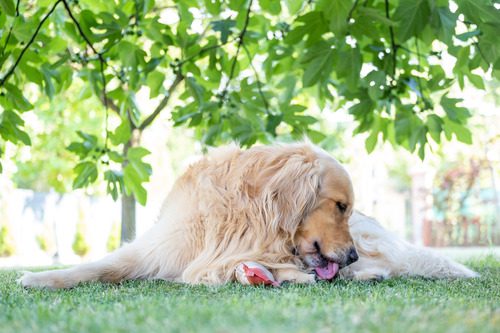You know your dog’s paws better than anyone—so when something seems off, it’s easy to worry. Maybe there’s a constant itch, a sudden limp, or a smell you can’t ignore. A dog paw yeast infection can cause all of this and more, turning everyday walks into a source of discomfort. The good news? Once you recognize the signs, you can take steps to help your dog feel better. In this blog, we’ll explore what causes these infections, how they’re treated, and what you can do to help prevent them from coming back. For expert care and guidance, call Brinker Veterinary Hospital in Lake Orion at (248) 693-1677 to schedule an appointment.

What Is a Dog Paw Yeast Infection?
Yeast infections are a common skin condition in dogs and frequently occur on the paws. Yeast is a naturally occurring fungus found on your dog’s skin, but under certain conditions, it can grow out of balance and lead to an infection.
Why the Paws?
A dog’s paws are warm, often damp, and exposed to various irritants daily, which can create a perfect environment for yeast overgrowth. Interdigital spaces (the areas between the toes) trap moisture and debris, making them especially vulnerable.
What Causes the Yeast to Overgrow?
The most common triggers for a dog paw yeast infection include:
- Allergies (environmental or food-related)
- Moisture buildup (from licking, swimming, or wet grass)
- Weakened immune system
- Bacterial infections that disrupt the skin’s balance
- Hormonal imbalances
Common Symptoms of a Dog Paw Yeast Infection
Identifying a dog paw yeast infection early can help prevent complications. The signs can vary, but the following symptoms are most often reported by dog owners and veterinarians.
Physical Signs to Watch For
- Redness and swelling, particularly between the toes
- A brownish discoloration or staining on the fur of the paws
- Scaly, thickened, or crusty skin
- Discharge or oozing in more advanced infections
Behavioral Clues
- Excessive licking or chewing at the paws
- Frequent pawing at the face
- Limping or favoring one paw over another
- Restlessness or changes in walking patterns
Odor and Texture
- A noticeable, musty or “corn chip” smell
- Sticky or greasy feel to the skin between the toes
These symptoms often worsen over time if the infection isn’t addressed. If you notice any of them, it’s time to reach out to your veterinarian for support.
Diagnosing a Dog Paw Yeast Infection
Veterinarians use several methods to diagnose a yeast infection in a dog’s paw. A physical exam, paired with a closer look under a microscope, helps confirm the presence of yeast.
Common Diagnostic Tools
- Skin scrapings or swabs to collect yeast samples
- Cytology (microscopic examination) to identify yeast cells
- Culture tests to rule out bacteria or other fungal organisms
- Allergy testing if chronic yeast infections are suspected
A proper diagnosis is key to effective treatment. In some cases, what appears to be a yeast infection may actually be a secondary issue caused by something else, like allergies or bacteria.
Addressing a Dog Paw Yeast Infection
Treating a dog paw yeast infection involves addressing both the symptoms and the underlying cause. Treatment varies depending on the severity and whether it’s a recurring issue.
In-Clinic Treatments
Your veterinarian may recommend topical or oral antifungal medications, along with medicated foot soaks or wipes. These options are designed to reduce yeast levels and soothe inflammation.
Managing Underlying Causes
If allergies, hormonal issues, or immune system problems are contributing to the infection, your veterinarian may recommend further testing or long-term management strategies.
Supporting the Healing Process
- Keeping your dog’s paws dry and clean
- Preventing licking with the use of an e-collar or protective booties (when advised)
- Routine follow-up visits to monitor progress
While treatment may take time, consistency and proper veterinary guidance play a major role in your dog’s recovery.
Preventive Measures to Help Reduce the Risk
Prevention plays an important role in reducing the likelihood of a dog paw yeast infection returning. Simple routines and awareness can make all the difference.
- Maintain Clean, Dry Paws: Moisture is one of the most common contributors to yeast overgrowth. After your dog walks in wet grass, snow, or puddles, take a moment to dry their paws thoroughly—especially between the toes.
- Grooming and Paw Checks: Regular grooming helps reduce buildup of dirt, allergens, and moisture. During grooming, check for signs of redness, flaking, or discharge. Early detection goes a long way.
- Dietary Support and Allergy Management: Work with your veterinarian to identify any food sensitivities or environmental allergies. A high-quality diet that supports skin and coat health may also help reduce yeast flare-ups.
- Consistent Veterinary Care: Routine wellness exams allow your veterinarian to catch subtle signs of skin or paw issues before they escalate. If your dog has a history of skin infections, ongoing monitoring may help prevent recurrence.
It’s always better to have your veterinarian assess changes in your dog’s paw health sooner rather than later. If your dog shows persistent licking, redness, or discomfort—or if you notice a strong odor—schedule an appointment with Brinker Veterinary Hospital by calling (248) 693-1677. Prompt care can prevent more severe infections and get your dog feeling better faster.
Recent Posts
About Us
At Brinker Veterinary Hospital we foster long, healthy lives with low-stress care and an array of services. Our team can’t wait to meet you and become a trusted partner in the care of your animal family member!
